Gwent Hands-on – we've played it and we love it!
Somebody could say that the card game from The Witcher 3 is not suited for multiplayer, but that somebody would be a liar. The standalone Gwent is not only pretty, but also complex and fun. It can really stir the genre.
Did you like Gwent in The Witcher 3? If the answer is “yes”, you can believe me when I say that you’re absolutely going to fall in love with it this fall. CD Projekt Red isn’t going to give us a mere “Gwent minus The Witcher”. Gwent is going to be a genuine video game, offering not only the option to compete against other players online (at last!), but also providing a 10-hour long campaign for the lone wolves: isometric perspective, new plot, map exploration, and fully voiced dialogues – you will hear your old friends from The Witcher, but there will also be many new characters. As if this wasn’t enough, the game is going to be totally free.
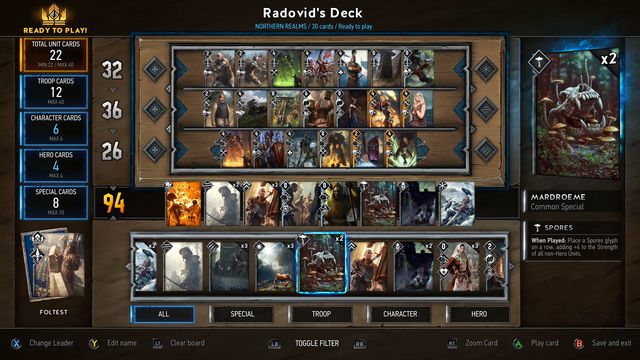
I would’ve lied if I said that I was expecting so many additional elements in a card game which, at the bottom, isn’t all that complicated – at least when compared to similar games. But CD Projekt Red didn’t go the easy way, and created a game which surprises you all the time. The first thing that draws attention is the beautiful visual layer – the artwork is fantastic, and from the technical standpoint, the screens are very legible and manage to explain all the nuisances of the game.
The standalone Gwent is all about novelty
Gwent in this new, standalone version has been thoroughly modified, and only the core of the game is similar to what we’ve seen in the Wild Hunt. The devs say that beginners should be able to comprehend the rules in fifteen minutes, but having played a couple rounds I’ve got no doubt – getting really good at this game will take some time, even to the Gwent masters of Passiflora. The changes concern the leader cards, which control the armies, as well as regular cards, which often have unexpected new bonuses. Triss Merigold card, for example, didn’t have any effects in The Witcher 3. Now it has two: Scorch, destroying the strongest card of the opponent, and the “Clear Weather” skill, neutralizing all currently active weather effects – of these abilities, one can be chosen by the player.
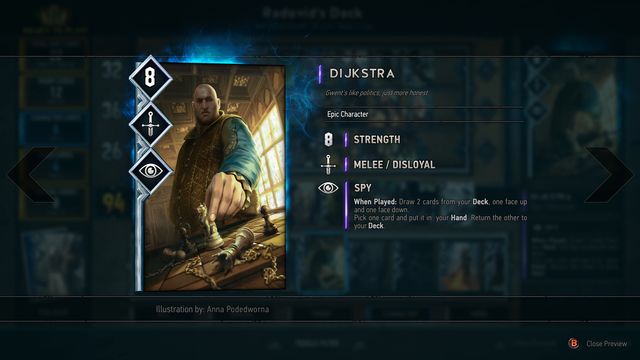
Avallac’h is still a spy card, but its value was changed from 0 to 12, which means that playing this card will permanently reinforce the opponent’s deck (contrary to his card in Witcher 3). The mechanics of spies were severely changed altogether. Those cards provided a huge advantage to Northern Kingdoms and Nilfgaard decks in the Wild Hunt, giving two additional cards at the expense of reinforcing the opponent’s deck. Now, the players can chose from two cards, among which only one is face-up.
New cards, new solutions
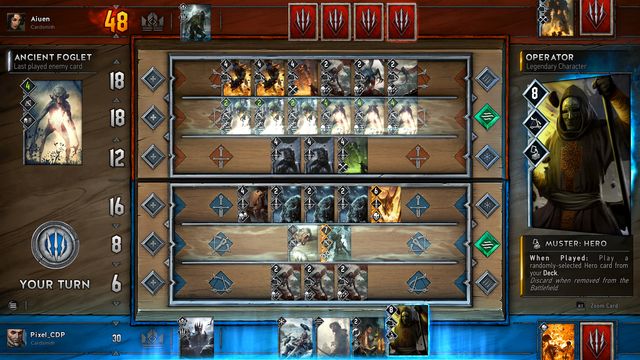
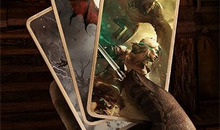
At the day of the release, four decks will be ready: Skellige, Northern Kingdoms, Scoia’tael, and Monsters. The absence of Nilfgaard will not last forever, though. The devs said they’re already working on implementing the much despised empire into the game, so we can assume it will come out as a DLC after Gwent is released.
Changes to the familiar cards are not the end of novelties, because all four decks will get some entirely new cards. A good example would be Shani – the girl from the first Witcher and Hearts of Stone. She will be a medic card – she can bring any lost card back onto the table, straight from the Graveyard – but that’s not all: the card brought back by Shani will become a hero card, and – as you probably remember – hero cards can’t be affected by any opponent’s abilities. Caranthir, the one guy painfully missing from the Monsters deck in The Witcher 3, is able to conjure onto the table any card which is not a hero card.
The Graveyard I mentioned is just a new, formal name for the discarded cards pile – for example those lost due to Scorch; all the cards used in one round go to the Graveyard as well. Gwent also allows you to browse through those cards, as well as through those that weren’t chosen for the deck before the game, so the players will be able to check the available moves easily.
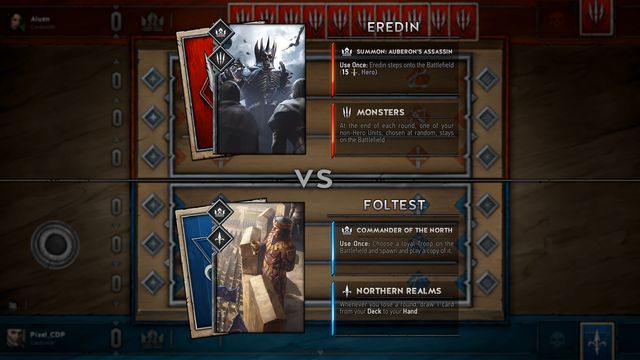
The leaders in the standalone Gwent no longer have multiple abilities. Crach an Craite, or Foltest, now have access to only one, unique ability. In return, CD Projekt Red have introduced some cmpletely new leaders – among them Dagon, known from the original game. The abilities themselves were also changed. For example, Foltest can now duplicate any card currently on the table.
Gwent in singleplayer
In Los Angeles we’ve tested Gwent in the PvP mode, but competing against other players isn’t the only way to play Gwent. CD Projekt Red is working on a full-scale single player campaign, in which the player will face AI opponents. It’s not going to be a simple set of increasingly difficult matches, but an actual adventure... only in isometric view. Hell yeah! Launching the single player mode, we will see pictures straight from classic role-plays such as Baldur’s Gate. There’s a pretty big map, which can be freely explored by the protagonist. When roaming the world, players can complete different quests (in the example shown at the conference, Geralt was escorting a little girl, Torina, accompanied by two mercenaries: Falibor and Milaen), as well as explore various locations. There are 2D comic book style cut-scenes, and voice-over done by the cast known from the Wild Hunt.
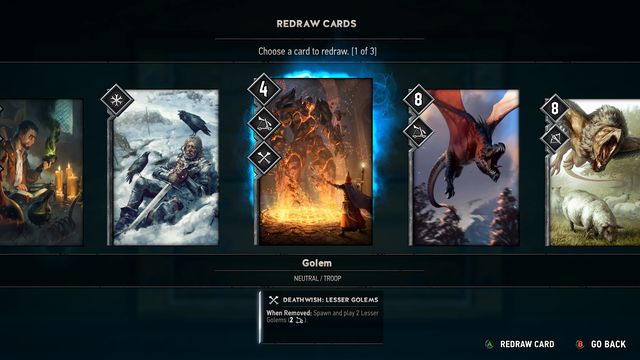
During exploration, the player will make decisions, resulting in different outcomes. During the showcase, Geralt had to decide whether to explore some dangerous ruins. I expected that decision to have a rather negative effect, but it turned out he was able to get a Scorch card. After getting back onto the trail, there was a fight which was a conclusion of a story quest. As you might’ve guessed, fights are resolved my means of a round of Gwent.
All these elements I mentioned add up and make for a very promising card game which may not be as popular as Hearthstone, but will certainly gather a substantial fanbase. The Reds have emphasized that they don’t want to modify the overall concept behind Gwent – which doesn’t utilize elements like mana or other such things; instead, the game depended entirely on the strength of the deck and skill of the player. Gwent is among those card games in which giving up one round can win you the whole match. When working on Gwent, Damien Monnier and his team always kept that fact in mind.
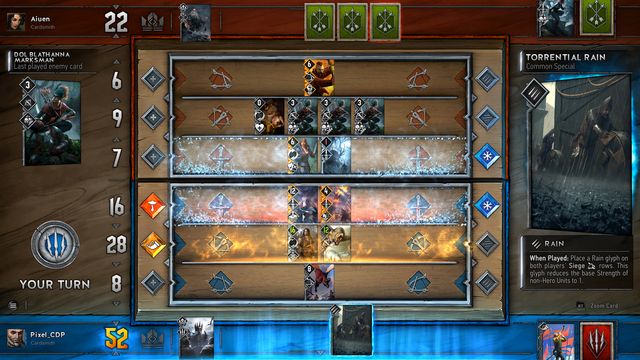
Waiting for more!
The authors say that they only started to work seriously on this game after The Witcher 3 was released. It was the reaction of the fanbase that compelled them to try something like that. After a year of work, Gwent is not only visually great, but also much more complex than its predecessor from The Witcher 3. How will it actually feel to play it – we will be able to see in September, when beta tests for PC and Xbox One are launched. Sometime later, the owners of PlayStation 4 will join the party, and those three platforms will be the first to receive the full game. What about mobile devices? We don’t really know yet. It’s feasible that a possible success of the game would eventually bring it to tablets, but it’s impossible to tell for certain.
CDPR are not revealing all of their plans concerning Gwent because it’s still a work in progress. Some controversies are being raised over the premium cards which can be purchased via microtransactions, but we don’t know any details. The devs promise genuine support for the game after its release; according to them, there will not only be new factions released, but new game modes as well. We are REALLY looking forward to Gwent.